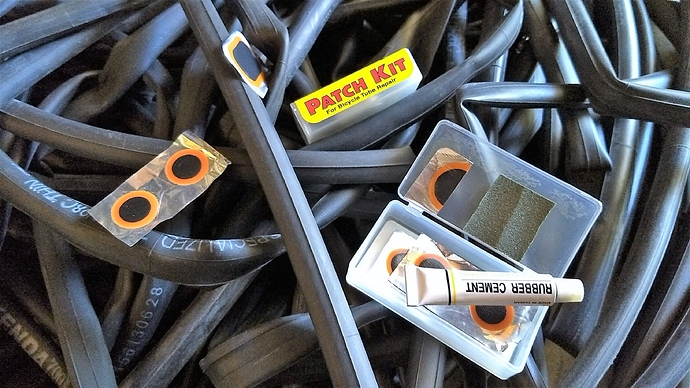One of our readers, Darren Randall, emailed:
I ride my road bike to commute to work only, I put 115 psi in my tyres, is it worth patching the tubes if I get a puncture?
I know it is easier to just put a new tube in the tyre but then there is the cost of buying a new tube each time. But then I do not want to waste time trying to patch tubes if it will not work and also have the inconvenience of flat tyres on the way to work.
Any advice would be appreciated.
Dear Darren:
I’m going to answer your question in two parts (and I’m assuming you mean regular butyl black tubes, not the fragile latex ones):
Part 1: A properly patched tube WILL WORK just fine and can last as long as an un-patched tube. This includes holding higher road tire pressures, like the 115 psi you use and more.
Part 2: Is it worth it? This depends on how you calculate savings and how you value your time.
By patching and re-using a tube, you save money directly versus the cost of buying a new tube.
Your costs to patching a tube are 1) a patch kit, 2) the time it takes to patch a tube, and 3) the odd occasion where you thought you patched it right, but didn’t.
-
Patch kits can be had at any local bike shop for usually $2-3. You’ll usually get 7-10 patches and glue - so enough to patch 7-10 tubes. If you pay $3 and get 10 patches, your materials cost per repair is $0.30 a tube.
-
Not sure how you value your time, but let’s say you make $15 an hour at work. If it takes 10 minutes to patch a tube (that’s a reasonable estimate of time it takes), that’s $2.50 worth of your time.
-
Depending on how good of a job you do, you may have a patch job fail. I think I do an okay job and my failure rate is probably 1 in 12. If I allocate the material and time costs ($2.80) plus another $1.25 (5 minutes time cost to change another tube) to the other 11 that worked, I allocate $4.05 / 11, or $0.37.
Total cost to patch and use a tube = $0.30 + 2.50 + 0.37 = $3.17. If a new tube costs $8, then the savings to patch and use one old bicycle tire tube is $4.83. And then there’s the incalculable, but worthwhile, savings to the environment.
As you can see, the biggest variable is your time value. If you could be doing something else for $45+ an hour, then you might be better off just buying new tubes.
BONUS TIPS:
-
Patch at home, not on the road (unless you have to). I typically ride with 2 spare tubes and some pre-glued patches. I only patch out on the road if I’ve already gone through my two spare tubes. Otherwise, I carry home the punctured tubes and patch them later.
-
Patch kits: Pre-glued patches are conveninent and work okay, but I’ve had mixed results on their effectiveness over the long-term, hence the reason I only patch with them as a last result on the road. When patching at home, I use the regular patches with self-vulcanizing glue.
-
Patching party: Okay, it’s not really a party, but it can be a bit of fun Zen time and more efficient when you do it in bulk. Gather your materials and several tubes that need repair, then patch them up one right after another.
-
Patch carefully and mitigate your risk: Patch tubes with small punctures, but let go the ones with large cuts or rips not easily covered by a standard size patch. Tubes are okay to be patched multiple times, but I don’t recommend stacking patches. If you carry two spare tubes on your ride, make one a new tube and the other a patched, this way if the patched one fails, you still have what should be a reliable back up.
Lastly, if you find it’s not worth it for you to patch, consider these:
-
Teach your child how to do it and then offer to pay them some amount to do it. This keeps them busy, it’s a good skill to have, and they can earn a little for their work.
-
Off them up to riding buddies or people in your local cycling club. If you won’t, someone else might like to have them to patch up.
-
If you or someone else won’t patch them, at least recycle your old tubes. Depending on your how your local trash is handled, they might be fine going into the recycle bin. Otherwise many shops take them and have programs to get them recycled.
I hope all this helps you and others. Happy patching!
-Anthony


